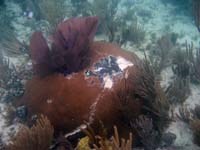
A. Bourque Biscayne National Park is known for its beautiful coral reefs that provide habitat for fish, invertebrates, and other organisms; protect the coastline of South Florida and attract thousands of visitors each year. 
A. Bourque While reefs may look "hard as a rock", the calcium carbonate material that reefs are made of is actually very fragile. Unfortunately, when vessels run aground on shallow coral reefs, the reefs can be seriously damaged or destroyed. 
A. Bourque Vessel groundings cause different types of injuries to coral reefs. The reef itself may be cracked, broken, or pulverized. Loss of structure reduces the reef's habitat quality, and increases the risk of further damage from erosion. 
A. Bourque Reef organisms that grow on the reef such as stony corals, octocorals, and sponges may be detached or broken by the grounded vessel. Because most corals grow extremely slowly, only an inch or two per year, loss of living coral is of great concern. 
A. Bourque The anti-fouling bottom paint from the hull of the vessel may become embedded in the reef. This paint is toxic to marine organisms, and will prevent recovery of reef creatures wherever it is found. 
A. Bourque Vessel groundings on coral reefs may also result in costly damage to vessels and personal property. 
A. Bourque The Habitat Restoration Program at Biscayne National Park conducts restoration at vessel grounding sites where the reef has been damaged, with the goal of accelerating recovery of these valuable resources. 
A. Bourque The type of restoration work conducted at a given site depends on the type of injuries that are found there. When the structure of the reef has been damaged, the reef is rebuilt to recreate lost structure. 
A. Bourque 
A. Bourque 
When the reef has been pulverized, rubble is stabilized so it won't cause additional damage if moved around by waves and currents. 
A. Bourque Broken corals and other reef organisms are reattached to the reef in an attempt to save as much live tissue as possible. Concrete is used for larger pieces, and cable ties are used for smaller pieces. 
D. Williams 
L. Canty Hull paint is scraped off the reef so that organisms may recolonize those areas. 
A. Bourque Restoration sites are monitored for a period of several years to track site stability and recovery of injured resources. |
Last updated: April 14, 2015
